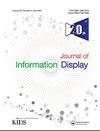Optical analysis of the dual-microcavity effect in a red light-emitting organic device
IF 3.4
3区 工程技术
Q2 MATERIALS SCIENCE, MULTIDISCIPLINARY
引用次数: 0
Abstract
ABSTRACT In this study, the effect of a dual microcavity on the luminescent characteristics and light extraction efficiency of organic red light-emitting devices with a multi-cathode structure was investigated. It was clarified that surface plasmon loss on a metal cathode was reduced to about one-fifth and can be efficiently extracted from the outside with the help of the dual-microcavity effect. About half of the radiant energy in dipole emission was successfully utilized as external and substrate modes. The luminous efficiency increased by about 1.52 times, and a narrow-band emission spectrum was observed with a forward directional red emission. The relationship between the luminescence characteristics and the dual-microcavity effect will be discussed from the viewpoint of the optical design of multi-stacked thin film devices.红色发光有机器件双微腔效应的光学分析
摘要在本研究中,研究了双微腔对多阴极结构有机红色发光器件的发光特性和光提取效率的影响。已经阐明,金属阴极上的表面等离子体损失减少到大约五分之一,并且可以在双微腔效应的帮助下从外部有效地提取。偶极发射中大约一半的辐射能被成功地用作外部模式和衬底模式。发光效率提高了约1.52倍,并且观察到具有正向红色发射的窄带发射光谱。将从多层薄膜器件的光学设计的角度讨论发光特性与双微腔效应之间的关系。
本文章由计算机程序翻译,如有差异,请以英文原文为准。
求助全文
约1分钟内获得全文
求助全文
来源期刊

Journal of Information Display
MATERIALS SCIENCE, MULTIDISCIPLINARY-
CiteScore
7.10
自引率
5.40%
发文量
27
审稿时长
30 weeks
 求助内容:
求助内容: 应助结果提醒方式:
应助结果提醒方式:


